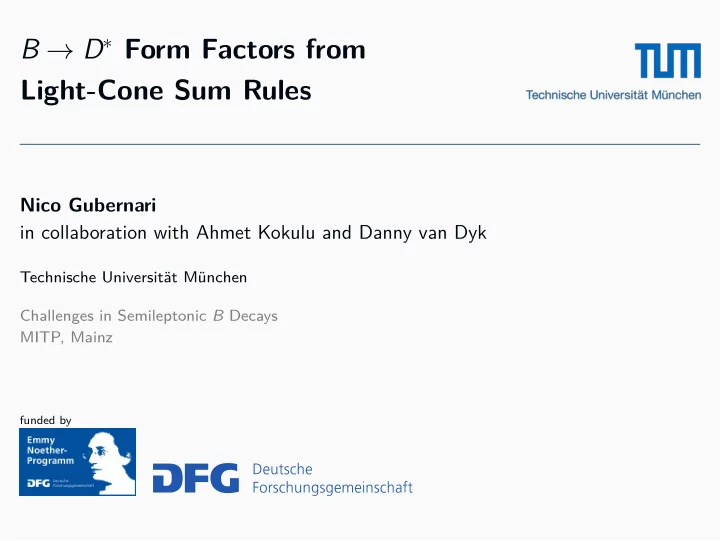

Light-Cone Sum Rules Nico Gubernari in collaboration with Ahmet Kokulu and Danny van Dyk Technische Universität München Challenges in Semileptonic B Decays MITP, Mainz funded by B → D ∗ Form Factors from
Motivations: why do we need B to D* FFs? • LCSRs complement Lattice results and Heavy Quark Expansion relations used in present analyses 1/4 • | V cb | extraction from branching ratios of B → D ∗ µν • prediction of R D ∗ in the SM, i.e. to constrain NP contributions to b → cl ¯ ν • B-LCSRs have 1 / m b corrections (related to twist expansion), but there is no 1 / m c expansion! • we present new twist 4 corrections to the B → D ∗ LCSRs, higher twists are expected to give corrections only of the order O ( 1 / m 2 b ) • O ( α s ) corrections are not considered
Light-Cone Sum Rules in a nutshell • determine products of exclusive hadronic matrix elements from an [Braun/Ji/Manashov ’17] results • new insights on LCDAs triggered our revisiting of these sum rule [Khodjamirian et al. ’06 + ’08] necessary non-perturbative input 2/4 ds • results of the non-local operator artifjcial, less-exclusive, non-local hadronic matrix element Π( k 2 , q 2 ) • Π( k 2 , q 2 ) calculable for kinematics that impose light-cone dominance J n , t ( s , q 2 ) ∫ ∑ Π( k 2 , q 2 ) = f B m B [ k 2 − s ] n ϕ t ( s ) n , t • J n , t can be computed from a hard scattering kernel • B-meson Light-Cone Distribution Amplitudes (LCDAs) ϕ t are • general B → V , B → P results available
Preliminary Results and Comparison 0.57 [Gubernari/Kokulu/van Dyk w.i.p.] [Gubernari/Kokulu/van Dyk w.i.p.] [Faller/Khodjamirian/Klein/Mannel ’06] ? +0.21 1.08 1.07 ? -0.01 0.70 0.78 FKKM2008 -0.21 ? 0.66 3pt tw3+4 GKvD2018 NEW Contrib. 2pt tw2+3 +3pt 2pt tw2+3 2pt tw4 0.73 0.65 -0.11 ? 3/4 B → D ∗ FF A 1 ( q 2 = 0 ) A 2 ( q 2 = 0 ) A 0 ( q 2 = 0 ) A 0 ( 0 ) / A 1 ( 0 ) [using the same input parameters, with q 2 the dilepton mass square] ϕ + , ϕ − 2-particle L+NL twist contributions g + new 2-particle NNL twist contributions ϕ 3 , ϕ 4 new and self-consistent 3-particle NL+NNL twist contr.
Plans for presentation of results convergence of the twist expansion fjrst before committing to use it • we plan to provide correlation matrices across form factors and across q 2 • we plan to provide numerical results in machine-readable form • probably JSON/YAML fjles, similar to what has been done for light-meson LCSRs [Bharucha/Straub/Zwicky ’15] • numerical evaluations are carried out with EOS and the code will be made publicly available at https://github.com/eos/eos 4/4 • we plan to give numerical results for all form factors at q 2 = 0 and q 2 = − 5 GeV 2 • we consider q 2 = + 5 GeV 2 as an additional point, but will check
Backup slides
Power corrections • correlator is calculated with on-shell B meson, using its Light-Cone Distribution Amplitudes (LCDAs) • B -meson LCDAs are defjned for bi-local currents involving an HQET fjeld h v increasing (collinear) twist • power corrections to this involve power of the covariant derivative iD µ • strings of the type iD µ 1 iD µ 2 . . . iD µ n are incorporated in LCDAs of
Benefjts of the Braun et al. basis [Braun/Ji/Manashov ’17] • inserting a gluon fjeld adds at least one unit of twist • 2-particle LCDAs start at twist 2, and are included in our results (up to and including twist 4) • 3-particle LCDAs start at twist 3, and are included in our results (up to and including twist 4) • 4-particle LCDAs have autonomous RG behaviour, do not mix with 3-particle LCDAs [Braun/Ji/Manashov ’17] • ϕ 3 , ϕ 4 , . . . are LCDAs of defjnite collinear twist 3, 4, . . . • LCDAs of twists ≥ 5 are expected to contribute beyond the next-to-leading 1 / m b corrections! • 4-particle LCDAs start at twist 4, and are not included in our results
Recommend
More recommend